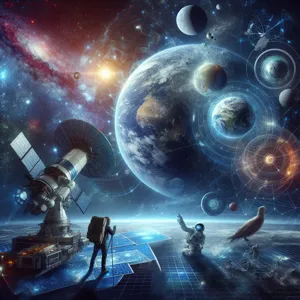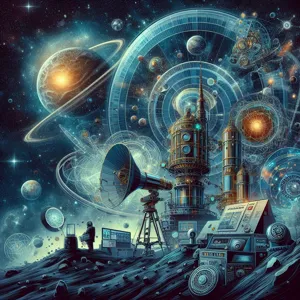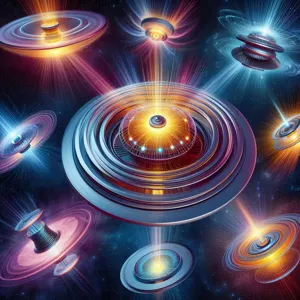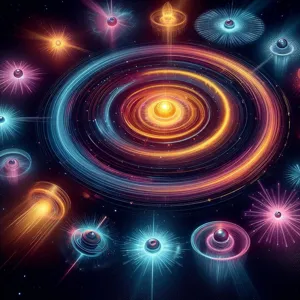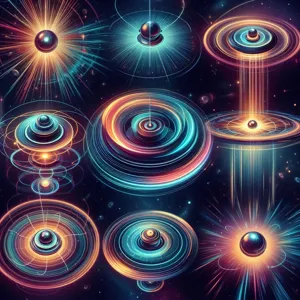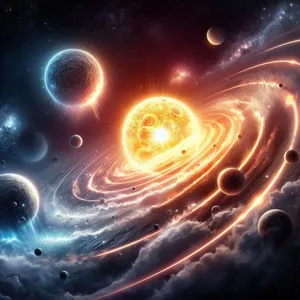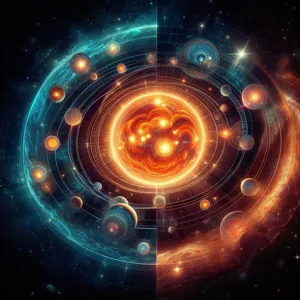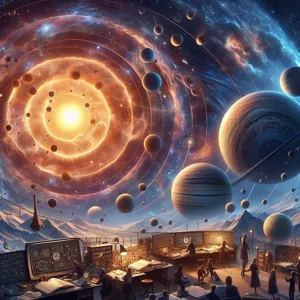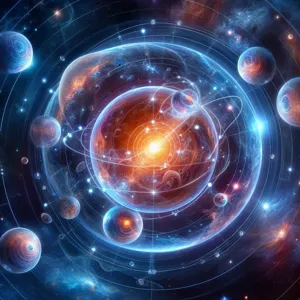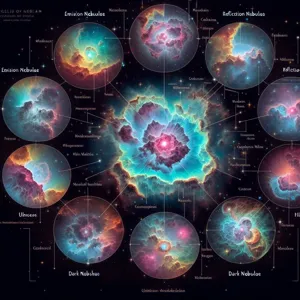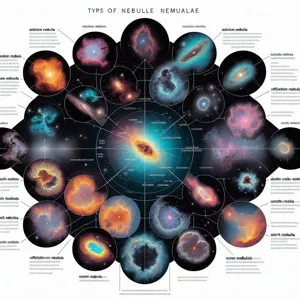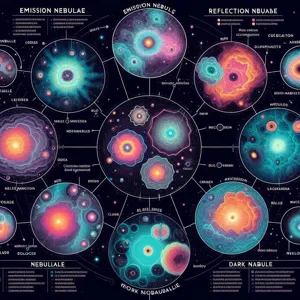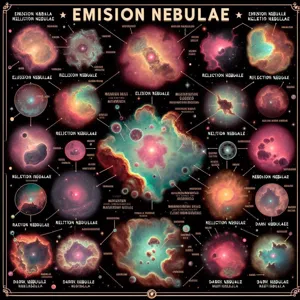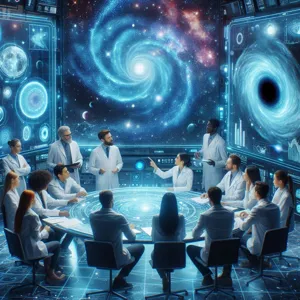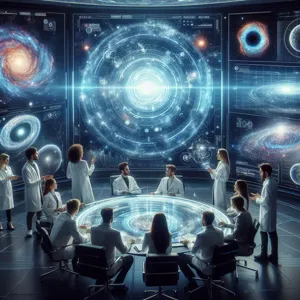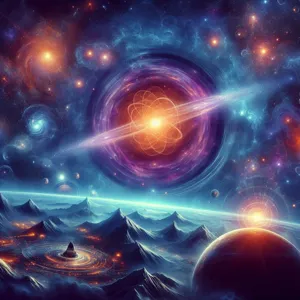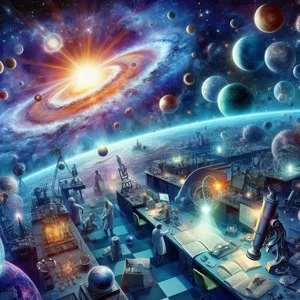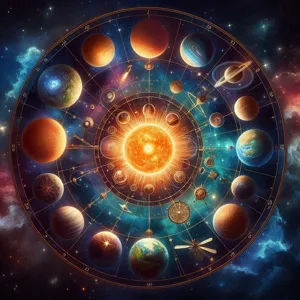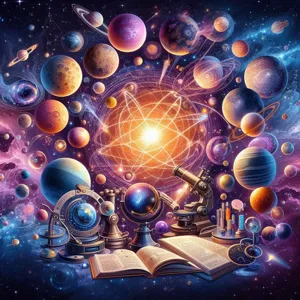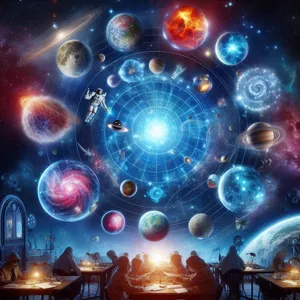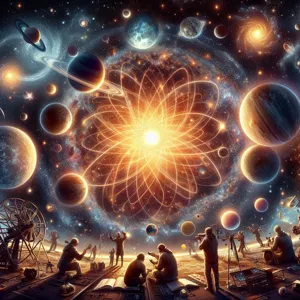Gazing up at the night sky has captivated humanity for millennia, inspiring wonder, curiosity, and a quest for understanding that transcends cultures and epochs.
From the ancient civilizations that charted the stars to the astronomers who revolutionized our perception of the universe, the history of astronomy is a rich tapestry woven with brilliant discoveries and profound insights. As we embark on this journey through time, we will explore the pivotal moments and figures that have shaped our understanding of the cosmos—from the early star-gazers who attributed divine meanings to celestial patterns, to the groundbreaking innovations of the Renaissance and the modern scientific revolution. Join us as we illuminate the milestones and the myths, the telescopes and theories, and celebrate the relentless human spirit that seeks to unravel the mysteries of the universe, one star at a time.
1. Introduction: The Fascination of Stargazing
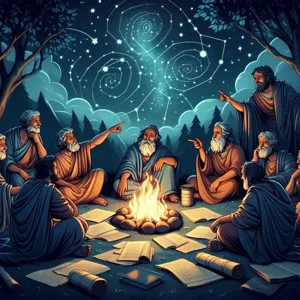
From the moment humanity first gazed up at the night sky, the stars have sparked a profound sense of wonder and curiosity. The twinkling lights scattered across the vast expanse above have served not only as navigational beacons but also as inspiration for countless myths, legends, and scientific inquiries. In ancient times, stargazing was a communal experience, with families and tribes gathering around fires to share stories under the celestial dome, their imaginations ignited by the constellations that told tales of gods, heroes, and cosmic battles.
As civilizations evolved, so too did our understanding of the heavens. The Babylonians meticulously charted the movements of celestial bodies, laying the groundwork for astrology and early astronomy. The Greeks and Romans expanded upon this knowledge, introducing philosophical concepts that sought to explain the universe’s structure and our place within it. The Renaissance ignited a new era of exploration, where figures like Copernicus, Galileo, and Kepler shifted the paradigm from an Earth-centered view of the cosmos to a heliocentric model, fundamentally altering our perception of reality.
Today, stargazing continues to captivate people of all ages, whether through amateur astronomy clubs, high-tech telescopes, or simply lying on a blanket under a starry sky. The allure of the cosmos transcends time and culture, offering a unique connection to our past and a glimpse into the mysteries that lie beyond our planet. In this journey through the history of astronomy, we will explore how our relationship with the stars has evolved, the key figures who shaped our understanding, and the technological advancements that have forever changed the way we observe the universe. Join us as we embark on this cosmic adventure, celebrating the enduring fascination of stargazing throughout the ages.
2. Ancient Civilizations and Their Celestial Observations
Stargazing has captivated human beings since the dawn of civilization, serving as a bridge between the earthly and the divine. Ancient civilizations, from the Babylonians to the Maya, laid the groundwork for astronomy as we know it today, meticulously charting the night skies and interpreting the movements of celestial bodies. Their observations were not mere pastimes; they were integral to agriculture, navigation, and religious practices.
The Babylonians, for instance, were pioneers in celestial mapping, utilizing their observations to develop one of the earliest known star catalogs. They identified constellations and tracked the movements of planets, doing so with remarkable precision. Their work in creating a lunar calendar demonstrated an advanced understanding of the cycles of nature, which they relied upon for planting and harvesting crops.
Meanwhile, in ancient Egypt, the alignment of pyramids and temples with the stars revealed a profound connection between their architectural grandeur and celestial phenomena. The Egyptians revered the sun god Ra and used the heliacal rising of Sirius to mark the annual flooding of the Nile—an event that was crucial for their agriculture.
Across the ocean, the Maya civilization took celestial observation to new heights. Their sophisticated calendar system, which included the Tzolk’in and the Haab’, was intricately tied to their astronomical observations. The Maya built observatories, such as the famous El Caracol at Chichen Itza, where they meticulously tracked the movements of Venus and other celestial bodies. Their understanding of cycles and eclipses was so accurate that they could predict astronomical events years in advance.
These ancient civilizations not only observed the stars but also wove their findings into the fabric of their cultures. Constellations were linked to mythology, legends, and rituals, creating a rich tapestry of beliefs that reflected their understanding of the universe. From agricultural practices to spiritual beliefs, the night sky served as both a guide and a source of wonder, shaping the lives of those who looked up and pondered the mysteries above.
As we delve into the history of astronomy, it’s essential to recognize the profound legacy of these ancient observers. Their passion for understanding the cosmos laid the foundation for future generations of astronomers and continues to inspire stargazers today. Through their eyes, we not only glimpse the stars but also the enduring human quest to comprehend the universe and our place within it.
3. The Contributions of Greek Astronomers

The Contributions of Greek Astronomers
Ancient Greece marked a pivotal era in the history of astronomy, laying the foundational stones for the science as we know it today. The Greek astronomers, driven by a thirst for knowledge and an insatiable curiosity about the cosmos, ventured beyond mere observation. They sought to understand the underlying principles governing celestial bodies, transforming stargazing into a systematic study.
One of the most influential figures of this time was Ptolemy, whose work, the *Almagest*, synthesized previous astronomical knowledge and introduced the geocentric model of the universe. This model posited that the Earth was at the center, with the sun, moon, stars, and planets revolving around it—a view that dominated Western thought for over a millennium. Ptolemy’s meticulous observations and mathematical calculations provided an early framework for predicting celestial events, paving the way for future astronomers to refine and challenge his theories.
Another remarkable contributor was Aristarchus of Samos, who boldly proposed a heliocentric model, suggesting that the sun, rather than the Earth, occupied the center of the universe. Though his ideas were overshadowed by Ptolemy’s geocentric theory during his time, Aristarchus’s revolutionary perspective would later inspire Copernicus and fundamentally change our understanding of the solar system.
Meanwhile, Hipparchus is often credited as the father of observational astronomy. He developed a comprehensive star catalog and introduced the magnitude system to determine a star’s brightness. His work laid the groundwork for future celestial navigation and inspired later astronomers to refine their methods and tools for observing the night sky.
The Greek astronomers also delved into the philosophical implications of their observations. Figures like Plato and Aristotle pondered the nature of the cosmos, influencing not just astronomy but also the broader fields of philosophy and science. Their inquiries into the nature of reality and existence prompted further exploration and contemplation, shaping the intellectual landscape of the Western world.
Together, these Greek astronomers expanded the boundaries of human understanding, transforming stargazing from a pastime into a rigorous discipline. Their contributions inspire us to look up at the stars with a sense of wonder, reminding us that our quest for knowledge about the universe is a journey that spans centuries. As we navigate the complexities of modern astronomy, we owe much to these ancient thinkers who dared to dream beyond the horizon of their time.
4. The Influence of the Middle Ages on Astronomy
The Middle Ages, often characterized as a time of stagnation in various fields, paradoxically marked a pivotal period for the development of astronomy. While Europe was enveloped in the shadow of the Dark Ages, the Islamic Golden Age illuminated the skies with profound advancements in celestial understanding. Scholars in the Islamic world meticulously preserved and expanded upon the astronomical knowledge of the ancient Greeks and Romans, translating crucial texts and building upon them with their own observations.
During this era, observatories were established, and the meticulous work of astronomers like Al-Khwarizmi and Al-Battani brought forth new techniques in celestial navigation and mathematical calculations. They developed sophisticated instruments such as the astrolabe, a device that allowed for the precise measurement of the positions of stars and planets. These innovations were not merely academic; they had practical applications in navigation, agriculture, and the timing of religious observances.
Meanwhile, in Europe, the influence of the Church loomed large, intertwining astronomy with theology. The geocentric model, which placed Earth at the center of the universe, became the dominant worldview, largely due to the writings of Ptolemy. This perspective was reinforced by religious doctrine, which saw humanity as the focal point of creation. However, as the Middle Ages progressed, the seeds for a shift began to take root. The translation of Arabic texts into Latin during the 12th century sparked a renewed interest in astronomy and philosophy. Figures like Copernicus would later challenge the established order, laying the groundwork for the Scientific Revolution.
In essence, the Middle Ages were far from a dark void for astronomy; they were a complex tapestry woven from the threads of preservation, innovation, and ideological conflict. This period set the stage for future breakthroughs, showcasing how the interplay between cultures and beliefs can shape our understanding of the cosmos. As we look back, we recognize that the stars were not silent witnesses; they were part of a vibrant dialogue that would ultimately lead humanity to question its place in the universe.
5. The Renaissance: A Turning Point in Astronomical Thought
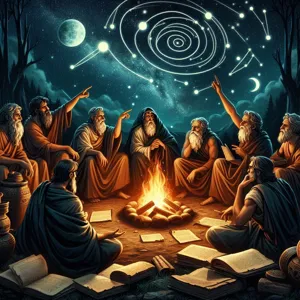
The Renaissance, spanning roughly from the 14th to the 17th century, marked a profound transformation in various fields, and astronomy was no exception. This era, characterized by a revival of classical knowledge and an insatiable curiosity about the natural world, shifted humanity’s perspective from a geocentric view of the universe to a heliocentric one. It was during this time that astronomers began to challenge long-held beliefs rooted in ancient texts, paving the way for a scientific revolution.
At the heart of this revolutionary period was the work of figures like Nicolaus Copernicus, whose seminal text, “De revolutionibus orbium coelestium,” proposed that the Earth and other planets orbit the Sun, rather than the other way around. This radical idea not only rekindled interest in astronomical observation but also laid the groundwork for future explorations of space. The Copernican model, although initially met with skepticism, offered a more straightforward explanation of celestial movements, sparking debates that would captivate scholars for generations.
As the Renaissance progressed, the invention of the telescope by Galileo Galilei in the early 17th century transformed stargazing from a philosophical endeavor into a rigorous scientific discipline. Galileo’s observations of celestial bodies, including the moons of Jupiter and the phases of Venus, provided compelling evidence for the Copernican theory, challenging the Aristotelian worldview that had dominated for centuries. His meticulous notes and stunning sketches of the night sky awakened a sense of wonder and inquiry that inspired countless others to look up and question what lay beyond.
This period also saw the contributions of Johannes Kepler, who formulated his three laws of planetary motion, which described the orbits of planets as elliptical rather than circular. Kepler’s work not only refined the heliocentric model but also united the previously disparate fields of astronomy and physics. The Renaissance was a time of immense progress, where art and science intertwined, leading to a deeper understanding of the cosmos and humanity’s place within it.
The shift in astronomical thought during the Renaissance was not merely an academic exercise; it was a cultural awakening. The stars, once thought to be fixed and unchanging, became dynamic objects of study, urging people to look beyond their earthly existence. As scholars began to embrace observation and experimentation, they laid the foundation for modern astronomy, forever changing the way we perceive the universe. This pivotal era reminds us that the quest for knowledge is ongoing, and the night sky continues to beckon us to explore further.
6. The Role of Telescopes in Advancing Astronomy
The Role of Telescopes in Advancing Astronomy
Telescopes have been the cornerstone of astronomical discovery since their invention in the early 17th century. When Galileo Galilei first turned his rudimentary telescope toward the night sky in 1609, he opened a window to the cosmos that had previously remained closed to humanity. With this simple yet revolutionary device, he observed the moons of Jupiter, the phases of Venus, and the intricate craters of the Moon, forever changing our understanding of the universe and our place within it.
As technology advanced, so too did the design and capabilities of telescopes. The development of the refracting telescope, which uses lenses to focus light, and the reflecting telescope, which employs mirrors, allowed astronomers to peer deeper into space with unprecedented clarity. The 18th century brought the great astronomer William Herschel, who discovered the planet Uranus and created a telescope that was the largest of its time. His work not only expanded the known boundaries of our solar system but also laid the groundwork for future astronomical exploration.
The 20th century ushered in a new era with the advent of powerful observatories and innovative technologies. The construction of the Mount Wilson Observatory and its 100-inch telescope in the early 1900s allowed astronomers like Edwin Hubble to make groundbreaking discoveries about the expansion of the universe. Hubble’s observations revealed that galaxies were moving away from us, leading to the formulation of the Big Bang theory.
Today, modern telescopes, both terrestrial and space-based, continue to push the boundaries of our knowledge. The Hubble Space Telescope, launched in 1990, has provided stunning images of distant galaxies, nebulae, and exoplanets, revolutionizing our understanding of the cosmos. Meanwhile, the upcoming James Webb Space Telescope promises to delve even deeper into the universe, observing the formation of stars and galaxies in unprecedented detail.
The evolution of the telescope is a testament to humanity’s insatiable curiosity and relentless pursuit of knowledge. Each advancement in telescope technology not only enhances our understanding of the universe but also inspires future generations of astronomers to reach for the stars. As we look ahead, it’s clear that the role of telescopes in advancing astronomy will remain pivotal, guiding us on our journey through the vast and mysterious cosmos.
7. Major Discoveries of the Enlightenment Era

The Enlightenment Era, spanning the late 17th to the early 19th century, was a period of remarkable intellectual transformation that significantly advanced our understanding of the cosmos. This age of reason was marked by a shift from reliance on tradition and superstition to a belief in empirical evidence and scientific inquiry. It was during this time that astronomy flourished, leading to groundbreaking discoveries that would forever change our perception of the universe.
One of the major figures of this era was Sir Isaac Newton, whose work laid the foundation for classical mechanics. In 1687, he published “Philosophiæ Naturalis Principia Mathematica,” which introduced the law of universal gravitation. This monumental work not only explained the motions of celestial bodies but also provided a mathematical framework that could predict their movements with unprecedented accuracy. Newton’s insights helped demystify the heavens, illustrating how the same physical laws governing the falling of an apple applied to the movements of the planets.
Simultaneously, the invention of the telescope revolutionized astronomy. Pioneers like Galileo Galilei and Johannes Kepler expanded our view of the night sky. Galileo, using the telescope he improved, made astonishing observations, including the moons of Jupiter, the phases of Venus, and the detailed surface of the Moon. These findings challenged the geocentric model of the universe and bolstered the heliocentric theory proposed by Copernicus, which posited that the Earth and other planets revolve around the Sun.
The Enlightenment also saw the emergence of modern observational techniques and the development of more refined instruments. The introduction of the reflecting telescope by Isaac Newton himself allowed for greater magnification and clarity, enabling astronomers to delve deeper into the cosmos. Meanwhile, Kepler’s laws of planetary motion provided a mathematical basis for understanding how planets orbit the Sun, introducing concepts such as elliptical orbits that would shape celestial mechanics.
As these discoveries unfolded, they sparked a sense of wonder and curiosity about the universe that rippled through society. The interconnectedness of science, philosophy, and culture during the Enlightenment created fertile ground for new ideas, inspiring countless individuals to look up at the stars and ponder their place in the vast expanse of space. This era not only deepened our understanding of celestial phenomena but also laid the groundwork for the scientific revolution that would follow, ushering in a new age of exploration and discovery in the field of astronomy.
In essence, the major discoveries of the Enlightenment Era not only advanced our scientific knowledge but also ignited a lasting passion for the stars that continues to inspire astronomers and stargazers alike.
8. The Birth of Modern Astronomy in the 19th Century
The 19th century marked a pivotal turning point in the field of astronomy, ushering in what many refer to as the birth of modern astronomy. This era was characterized by a profound transformation in both observational techniques and theoretical frameworks, laying the groundwork for the sophisticated astronomical practices we know today.
During this period, the invention and refinement of telescopes revolutionized our ability to observe celestial bodies. Notable figures such as William Herschel, who discovered Uranus and infrared radiation, and his sister Caroline Herschel, who cataloged numerous comets, expanded our understanding of the solar system and beyond. The introduction of photography in astronomy also opened new avenues for exploration. The ability to capture images of distant stars and galaxies allowed astronomers to create detailed celestial maps, enhancing our comprehension of the universe’s structure.
Additionally, the 19th century was a time of great theoretical advancements. The formulation of the nebular hypothesis by scientists like Pierre-Simon Laplace proposed that the solar system formed from a rotating cloud of gas and dust, paving the way for modern astrophysics. This period also saw the rise of spectroscopy, which enabled astronomers to analyze the light emitted by stars, leading to groundbreaking discoveries about their composition and temperatures.
Furthermore, the establishment of observatories around the world, such as the famous Mount Wilson Observatory in California, provided astronomers with the tools and resources needed to conduct systematic observations. These institutions became hubs of scientific collaboration, fostering the exchange of ideas and discoveries that propelled the field forward.
As the 19th century drew to a close, the groundwork for modern astronomy was firmly in place, setting the stage for the 20th century’s astronomical revolution. The advances made during this time not only deepened our understanding of the cosmos but also ignited a passion for exploration that continues to inspire astronomers and enthusiasts alike today. From the meticulous observations of the past to the technological innovations of the present, the legacy of 19th-century astronomy remains a cornerstone of our ongoing quest to unravel the mysteries of the universe.
9. The Impact of Space Exploration in the 20th Century
The 20th century marked a transformative era in the field of astronomy, characterized by groundbreaking advancements and a collective curiosity that propelled humanity into the cosmos. The impact of space exploration during this century cannot be overstated; it reshaped our understanding of the universe and our place within it.
The launch of Sputnik 1 by the Soviet Union in 1957 heralded the dawn of the space age, igniting a fierce competition between nations and sparking a wave of technological innovation. This small satellite, which beeped its iconic signal from orbit, was not just a scientific achievement; it was a symbol of possibilities that lay beyond our planet. The subsequent exploration missions, including Yuri Gagarin’s historic flight in 1961, captured the world’s imagination and inspired generations to look upward.
The United States responded with vigor, culminating in the Apollo program, which famously landed humans on the Moon in 1969. Neil Armstrong’s first steps on the lunar surface were not just a monumental achievement in engineering and science; they represented a pivotal moment in human history. The images of the Earth rising above the Moon’s horizon reminded us of our planet’s fragility and interconnectedness—a perspective that continues to resonate today.
Beyond the Moon, the latter part of the century saw the launching of space telescopes and robotic probes that expanded our understanding of the solar system and beyond. The Hubble Space Telescope, launched in 1990, opened a new window to the universe, capturing breathtaking images and providing invaluable data that revolutionized our comprehension of galaxies, nebulae, and cosmic phenomena. Meanwhile, missions like Voyager 1 and 2 ventured into the far reaches of our solar system, sending back data that still informs our understanding of planetary atmospheres and the characteristics of distant worlds.
As we reflect on the impact of space exploration in the 20th century, it becomes clear that this era was not merely about technological advancements; it was about a collective awakening. The pursuit of knowledge about the cosmos fostered international collaboration and ignited interest in science and technology across the globe. It challenged our perceptions, stirred our imaginations, and laid the groundwork for future explorations that continue to push the boundaries of human knowledge. The legacy of this remarkable century reminds us that the stars are not just distant points of light; they are the destination of our ongoing quest for understanding and discovery.
10. Key Figures in the History of Astronomy
The history of astronomy is rich with visionary thinkers and pioneers who have shaped our understanding of the cosmos. From the ancient philosophers who first looked to the stars, to the modern scientists who continue to unravel the mysteries of the universe, each key figure has contributed unique insights that have propelled the field forward.
**1. Ptolemy (c. 100 – 170 AD)**
Often regarded as one of the most influential astronomers of antiquity, Claudius Ptolemy’s geocentric model of the universe dominated Western astronomical thought for over 1,400 years. His seminal work, the *Almagest*, meticulously detailed the movements of celestial bodies and introduced the concept of epicycles, which explained the retrograde motion of planets. Although ultimately replaced by the heliocentric model, Ptolemy’s contributions laid the groundwork for future astronomers.
**2. Copernicus (1473 – 1543)**
Nicolaus Copernicus dramatically shifted the paradigm of astronomy with his revolutionary heliocentric theory, positing that the Sun, rather than the Earth, was at the center of the universe. His groundbreaking book, *De revolutionibus orbium coelestium*, published shortly before his death, sparked the Copernican Revolution and challenged centuries of entrenched beliefs about our place in the cosmos.
**3. Galileo Galilei (1564 – 1642)**
Often hailed as the father of modern observational astronomy, Galileo’s innovative use of the telescope allowed him to make groundbreaking discoveries, including the moons of Jupiter and the phases of Venus. His championing of the heliocentric model and insistence on evidence-based science faced significant opposition from the Church, leading to his infamous trial. Nevertheless, Galileo’s work laid the foundation for a new era of scientific inquiry.
**4. Johannes Kepler (1571 – 1630)**
A contemporary of Galileo, Kepler formulated his three laws of planetary motion, which described the elliptical orbits of planets around the Sun. His meticulous mathematical approach to astronomy not only supported Copernicus’s heliocentric theory but also paved the way for future astronomers, including Isaac Newton, to formulate the laws of gravitation. Kepler’s work exemplifies the blend of precise observation and mathematical modeling that characterizes modern astronomy.
**5. Isaac Newton (1643 – 1727)**
Isaac Newton revolutionized astronomy with his laws of motion and universal gravitation, encapsulated in his landmark work, *Philosophiæ Naturalis Principia Mathematica*. Newton’s insights explained the forces that govern celestial bodies and provided the mathematical language that would dominate physics and astronomy for centuries. His contributions laid the essential groundwork for the scientific revolution and established a framework for understanding the universe.
These figures, among many others, have been instrumental in the evolution of astronomy, each contributing a piece to the cosmic puzzle. Their legacies remind us of the relentless human curiosity that drives our quest to understand the universe and our place within it. As we continue to explore the heavens, we stand on the shoulders of these giants, inspired by their discoveries and emboldened by their courage to question the known.
11. The Development of Astrophysics and Cosmology
The Development of Astrophysics and Cosmology marks a pivotal chapter in the history of astronomy, where the mysteries of the universe began to be unraveled through rigorous scientific inquiry and innovative thinking. In the late 19th and early 20th centuries, astronomers transitioned from mere observational studies of celestial bodies to a deeper understanding of the underlying physical laws governing the cosmos. This shift was largely fueled by the advent of new technologies, such as the spectroscope, which allowed scientists to analyze the light emitted by stars and galaxies, revealing their composition, temperature, and movement.
One of the towering figures of this era was Albert Einstein, whose theory of general relativity revolutionized our understanding of gravity and its impact on the fabric of space and time. This groundbreaking theory not only explained the orbits of planets but also predicted phenomena such as the bending of light around massive objects, which would later be confirmed through observation. The implications of Einstein’s work laid the groundwork for modern cosmology, prompting astronomers to consider the universe as a dynamic entity rather than a static backdrop.
As the 20th century progressed, the field of astrophysics blossomed with the introduction of new concepts, such as the Big Bang theory, which posited that the universe originated from a singular, infinitely dense point approximately 13.8 billion years ago. This idea was bolstered by the discovery of cosmic microwave background radiation, a remnant heat signature from the early universe, providing compelling evidence for the explosive expansion of space.
Furthermore, advancements in technology, such as the Hubble Space Telescope, have opened new windows into the cosmos, allowing us to peer deeper into the universe and observe distant galaxies, star formation, and the intricate dance of celestial mechanics. Today, the study of astrophysics and cosmology continues to evolve, incorporating concepts from quantum mechanics and the exploration of dark matter and dark energy—enigmatic components that make up a significant portion of the universe yet remain largely mysterious.
The journey through the development of astrophysics and cosmology is a testament to humanity’s insatiable curiosity and relentless pursuit of knowledge. As we continue to seek answers to age-old questions about the origins and structure of the universe, one thing remains clear: the cosmos is a vast tapestry, intricately woven with the threads of science, philosophy, and wonder, inviting us to explore its depths now and in the future.
12. The Rise of Digital Astronomy and Technology
The Rise of Digital Astronomy and Technology marks a transformative era in our understanding of the cosmos, fundamentally altering the way we observe, analyze, and interpret celestial phenomena. As we transitioned into the late 20th and early 21st centuries, the advent of digital technology revolutionized the field, providing astronomers with unprecedented tools to explore the universe.
In this new age, traditional telescopes were enhanced with digital cameras and sensors, allowing for clearer, more detailed images of distant galaxies, nebulae, and celestial bodies. The introduction of software to process and analyze vast amounts of data meant that astronomers could uncover patterns and insights that were previously impossible to detect. For instance, the Hubble Space Telescope, launched in 1990, has provided breathtaking images and invaluable data about the universe, expanding our knowledge of everything from black holes to the formation of stars.
Moreover, the rise of computer simulations has allowed scientists to model complex astronomical phenomena, from the dynamics of planetary systems to the evolution of the universe itself. These simulations not only enhance our understanding but also serve as vital tools for predicting future events, such as asteroid impacts or the behavior of distant exoplanets.
The digital age has also democratized astronomy, making it more accessible to amateur stargazers and enthusiasts. Online platforms and mobile applications now enable anyone with a smartphone to explore the night sky, identify constellations, and even contribute to citizen science projects that aid professional researchers. This sense of community and collaboration has fostered a renewed passion for astronomy, inviting people from all walks of life to participate in the exploration of our universe.
As we look ahead, the integration of artificial intelligence and machine learning is poised to further enhance our astronomical endeavors. These technologies will allow for even more sophisticated data analysis, enabling astronomers to sift through the massive amounts of information generated by modern telescopes and automatically identify celestial events worthy of further study.
In essence, the Rise of Digital Astronomy and Technology is not just a chapter in the history of astronomy; it’s a new frontier that continues to push the boundaries of human knowledge, bridging the gap between Earth and the vast, mysterious universe beyond. With every digital leap forward, we not only observe the stars but also deepen our connection to the cosmos, unraveling the intricate tapestry of the universe one pixel at a time.
13. Contemporary Challenges and Frontiers in Astronomy
As we venture into the 21st century, the field of astronomy is at the forefront of scientific discovery, grappling with contemporary challenges and exploring new frontiers that promise to redefine our understanding of the cosmos. One of the foremost challenges faced by astronomers today is the sheer vastness of the universe, coupled with the limitations of our observational technologies. Despite significant advancements, the challenge of capturing and analyzing the massive amounts of data generated by modern telescopes can be daunting. The overwhelming influx of information from space observatories, satellites, and ground-based telescopes requires innovative data processing techniques and powerful algorithms to sift through and extract meaningful insights.
Moreover, the search for extraterrestrial life has entered an exciting yet challenging phase. The discovery of exoplanets in habitable zones around distant stars fuels our curiosity, but it also poses the question of how to effectively study and characterize these worlds. The upcoming James Webb Space Telescope (JWST), with its advanced capabilities, aims to push the boundaries of our understanding, yet we must also confront the ethical implications of our searches. As we seek to explore and potentially colonize other planets, considerations around planetary protection and the preservation of extraterrestrial environments come to the forefront of discussions.
In addition to these scientific hurdles, astronomers are also responding to the rapid advancement of technology. The rise of citizen science has democratized astronomy, allowing enthusiasts to contribute to research projects and data analysis. This shift presents both opportunities and challenges, as professional astronomers must find ways to integrate and validate the contributions from amateur astronomers while maintaining rigorous scientific standards.
Finally, climate change and light pollution pose significant environmental challenges to astronomical observation. As urban areas expand, the night sky becomes increasingly washed out, obscuring our view of the stars. Advocating for dark sky initiatives and sustainable practices is essential to ensure future generations can gaze up at the cosmos with wonder.
In this era of unprecedented discovery, the field of astronomy stands at a crossroads, balancing the excitement of new frontiers with the challenges of ethical responsibility, environmental stewardship, and technological integration. As we look up at the night sky, we are reminded that our journey through time is not just about the stars and planets, but also about the choices we make to navigate the complexities of our universe.
14. Cultural Perspectives on Astronomy Throughout History
Astronomy is not merely a science; it is a narrative woven into the cultural fabric of societies throughout history. Different civilizations have gazed up at the same stars, yet their interpretations and significances have varied dramatically, reflecting their unique worldviews, beliefs, and values. From the ancient Egyptians who aligned their pyramids with the stars to the Indigenous peoples who crafted rich oral traditions around celestial phenomena, cultural perspectives on astronomy have shaped human thought and societal structures.
In ancient Mesopotamia, astronomers meticulously documented the movements of celestial bodies, leading to the creation of one of the earliest known calendars. Their observations were not just scientific endeavors; they were deeply intertwined with religious practices, as planets and stars were often regarded as the manifestations of powerful deities. Similarly, the Maya civilization developed a complex astronomical system that governed not only agricultural practices but also religious ceremonies, demonstrating how astronomy can influence both daily life and spiritual beliefs.
In contrast, the philosophies of ancient Greece introduced a more systematic approach to understanding the cosmos. Thinkers like Ptolemy and Aristotle laid the groundwork for a geocentric model of the universe that dominated Western thought for centuries. Their work sparked debates that would ultimately ignite the Renaissance, leading to revolutionary ideas from figures like Copernicus and Galileo, who challenged long-held beliefs and shifted humanity’s perspective on its place in the universe.
Meanwhile, in the East, cultures such as the Chinese and Indian civilizations developed their own rich astronomical traditions. The Chinese, with their emphasis on harmony and balance, viewed celestial events as omens that could influence earthly affairs, while Indian astronomers made significant contributions to mathematics and observed the cosmos through a spiritual lens, intertwining astronomy with astrology and philosophy.
As we traverse this historical landscape, it becomes clear that the stars have always inspired humanity’s quest for knowledge and meaning. Each culture has contributed unique insights to our understanding of the universe, illustrating that astronomy is not just a scientific pursuit, but a shared human experience that transcends time and geography. Today, as we stand on the shoulders of these giants, it is essential to appreciate the diverse cultural perspectives that have shaped our understanding of the cosmos and continue to inspire future generations of stargazers.
15. Conclusion: The Ever-Evolving Journey of Stargazing
As we conclude our exploration of the fascinating history of astronomy, it’s clear that stargazing has always been more than just a pastime; it’s a profound journey that connects humanity to the cosmos. From the ancient civilizations who traced the movements of celestial bodies to predict seasons and navigate the seas, to the cutting-edge telescopes and space missions of today, our understanding of the universe has evolved in remarkable ways.
The stars have served as guides for countless generations, inspiring mythologies, shaping cultures, and igniting the imaginations of dreamers and scientists alike. Each era brought forth its own discoveries, from the heliocentric model that revolutionized our view of the solar system to the recent advancements in astrophysics that challenge our understanding of dark matter and black holes.
Today, stargazing continues to captivate millions, with advancements in technology making the cosmos more accessible than ever. Whether through powerful telescopes, smartphone apps that identify constellations, or virtual reality experiences that simulate distant galaxies, the night sky invites us to ponder our place in the vast universe.
As we look ahead, the journey of stargazing is far from over. With ongoing missions to Mars, the exploration of exoplanets, and the quest for extraterrestrial life, we stand on the cusp of new discoveries that could redefine our understanding of existence itself. So, as you lay back beneath the stars, remember that you are part of an ever-evolving story—a narrative written in the language of light and time, inviting you to dream, wonder, and reach for the heavens.
As we conclude our journey through the captivating history of astronomy, we hope you’ve gained a deeper appreciation for the celestial wonders that have fascinated humanity for millennia. From the ancient stargazers who first mapped the night sky to the groundbreaking discoveries of modern astronomers, the evolution of our understanding of the cosmos is a testament to human curiosity and ingenuity. As you gaze up at the stars, remember that you are part of an ongoing story—one that connects us all through time and space. Whether you’re an experienced astronomer or a curious newcomer, we encourage you to keep exploring, questioning, and marveling at the universe. After all, the night sky holds countless mysteries yet to be unveiled, and your journey in astronomy has only just begun. Happy stargazing!






